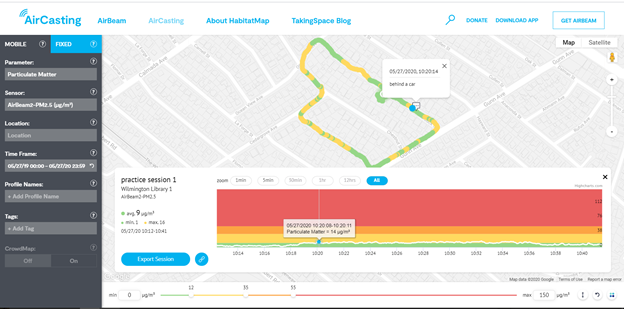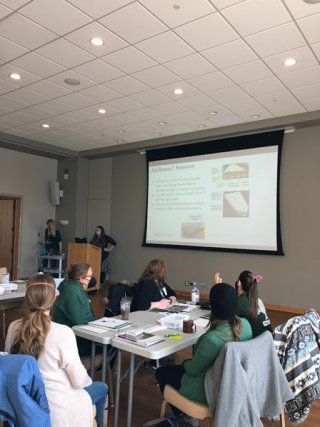Five Hands-on Lesson Plans: Using Air Sensors to Teach About Air Quality

Published December 13, 2022
EPA scientists and collaborators designed five hands-on lesson plans to encourage air quality education in communities and classrooms. Using air sensor technology, participants of all ages can use information in their own communities to explore real-time air quality and air pollution concepts.
The team of researchers including Dr. Andrea Clements, Dr. Rachelle Duvall, Ryder Freed, Sheila Batka, Megan Gavin, Christi Duboiski, India Young, and Sarah Waldo, developed the lesson plans as a complement to EPA’s pilot air sensor loan programs. These programs make sensors more accessible to communities through partnerships with local libraries, museums, and tribal-serving organizations. Through these programs, individuals and groups can use handheld or stationary air sensors to explore outdoor and indoor air pollution sources and learn how to reduce exposure to air pollution.
“We wanted to support our partners in the loan programs by having activities ready at hand,” says Clements, one of the project co-leads. “We also wanted to facilitate air quality education opportunities, and we wanted to make sure that those were focused on topics of interest to the community.”
Between 2019 and 2021, EPA launched pilot air sensor loan programs with community partners and EPA regional offices that serve several Midwestern states, the city of Los Angeles, and tribal communities in the Pacific Northwest. The team successfully navigated challenges from the COVID-19 pandemic to train library staff and others to use the air sensors.

“Part of the project’s success was the collaboration that led to resources for individuals and groups to learn about air quality and sensors,” says Duvall, another co-lead on the project. “All of the resources developed to support the program, including the lesson plans, are helping improve environmental literacy of the partners and helping them offer new, hands-on education and other programming to their communities.”
The activities in the lesson plans can be adapted for different audiences and age groups and are aligned with Next Generation Science Standards, allowing them to be used in classrooms. Each lesson plan comes with instructor and participant guides, introductory slides for key air quality concepts, activity worksheets and answer keys, and an extension activity for learners who want to know more. Additional resources for instructors and community groups include a user guide for loaned air sensors, frequently asked questions, and supplemental information on air quality, sensors, and data analysis.

EPA’s loan program partners continue to expand on lesson plan applications since launching the programs. For example, the Nez Perce Tribe in Idaho have plans to incorporate additional sensor technology and have translated some materials into their native language. The Morton Arboretum in Illinois expanded on “The Power of Plants!” lesson plan and hosted a teacher workshop that trained 40 educators on the air quality education resources. And, the Los Angeles Public Library in California created school lending kits, bundling sensors with smartphones and lesson plans so that educators can engage students in their classrooms.
The lesson plans and additional resources are publicly available and adaptable. The team hopes that these lesson plans will help individuals and communities learn about air quality and air sensors, and potentially inspire the next generation of scientists and engineers. So far, that future looks bright as Katie Reineke, the Experience Manager at the Evansville Vanderburgh Public Library in Indiana, can attest. She noted, “Oh, the questions! Curiosity is ripe. ‘I wonder what caused that spike!’ ‘What was happening when that change occurred?’ Nothing is more fun than watching people’s minds fire up and go!”
The air quality lesson plans include:
- What is in the Outdoor Air? Exploring Particulate Matter (PM) Sources and Air Quality Outdoors
Encourages exploration of outdoor air quality and particulate matter pollution sources using a handheld air sensor. - Hidden Particulate Matter Indoors! Explore Your Environment
Provides activities for exploring indoor air quality and particulate matter sources using a handheld air sensor. - My Pollution Bubble! Exploring My Personal Particulate Matter (PM) Exposure
Learners explore their personal exposure to air pollution and particulate matter sources using a handheld air sensor. - The Power of Plants! How Vegetation Can Help Protect Us from Air Pollution
Teaches learners about how certain types of vegetation can help protect people from particulate matter pollution. Participants explore the air in their community using a handheld sensor. - Is that Smoke Affecting Me? Using Crowdsourced Public Data to Explore Air Quality During Smoke Events
Participants learn how to use crowdsourced data to explore air quality during smoke events, investigate data trends, and protect themselves from smoke exposure. This lesson uses an optional stationary particulate matter sensor and the AirNow Fire and Smoke Map.
Related Resources:
Educational Resources Related to Air Sensor Technology
